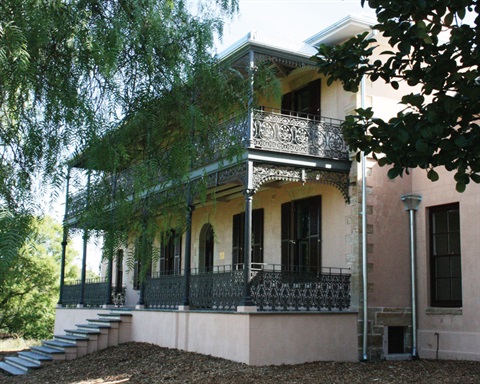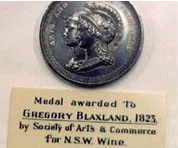Brush Farm House

Located at: 19 Lawson Street, Eastwood
Brush Farm House was built circa 1820 by Gregory Blaxland, following his purchase of the Brush Farm Estate in 1807. It is not only one of Australia's oldest houses but also one of the most substantial houses surviving from the Macquarie period. Brush Farm House represents a nationally important site where some of the colony's initial land grants were made. Brush Farm House stands on part of a grant made to Zadoc Petit of 25 acres in 1794.
Through 1794-1797, additional grants were made to various parties that were consolidated by Lt. William Cox during 1800-1801, before their sale to Gregory Blaxland in 1807. The area represents one where the earliest phases of European settlement and expansion of Australia occurred. The first European settlement of the area which would later be called Ryde occurred in 1792.

The full Palladian composition of Brush Farm House makes it one of the most architecturally pretentious of extant early colonial houses and relates it to such buildings as Old Government House and also to Provincial Georgian architecture in Ireland and the United Kingdom.
Photo: Medal awarded to Gregory Blaxland in 1823 by Society of Arts and Commerce for NSW wine. Grapes for the wine were grown on Brush Farm.
The interior of the house retains some examples of Regency joinery and the 1880s alteration of the building is an example of late Victorian aggrandisement and contains features typical of the period such as two storey cast iron verandah, internal timber joinery, staircase, ceilings and cornices. The house retains a good example, albeit much repaired, of an Edwardian period institutional hall. The siting of the house complements the original pretentious Palladian design which incorporates a raised platform and semi-detached side wings.

Brush Farm House retains its original aspect to and visual links with the Parramatta River and an unusually large part of the original estate is in a relatively undeveloped state. The site contains a few remnants of the early nineteenth century adaptations of the landscape including the cisterns, wells and traces of a former carriage loop and drive. The site also retains substantial remnants of late Victorian and turn of the century adaptations to the landscape including garden tree plantings.
Photo (right): Brush Farm Carpentarian Reformatory, quarters, 1910
Gregory Blaxland devoted much of his time at Brush Farm to agricultural experimentation. He tried, unsuccessfully, to cultivate hops and his experiments with cattle and sheep fodder resulted in the Estate being the first farm in the colony to cultivate buffalo grass for fodder. Gregory Blaxland and his brother John are the real founders of the nation's cattle industry. It can be argued that they did for the cattle industry, from Gregory Blaxland's Brush Farm Estate, what MacArthur and Marsden did for the sheep industry.
Although gaining greater national recognition for his part in the crossing of the Blue Mountains, Blaxland's greatest international recognition arose through his attempts at viticulture at the Brush Farm Estate. In 1822 he made history by shipping one quarter of a pipe of red wine, fortified with brandy to London, where the Society for the Encouragement of Arts, Manufactures and Commerce awarded him a silver medal in 1823.
A second sample offered to the Society in 1828 won Blaxland the Society's Gold Ceres Medal (This medal is held by the Mitchell Library, State Library of New South Wales). It is somewhat surprising that Gregory Blaxland is not more widely recognised as the true founder of the wine industry in this country, although others before him had tried and failed, he persevered and persisted until he was in a position to export the first wine from this country from his, reported to be the Claret grape, grown on the Brush Farm Estate.
Subsequent owners
Between 1831 and 1880 Brush Farm House and the Estate was owned by the Forster family, which included the one time premier of NSW, William Forster who entered the colonial legislature in 1853 and served in 9 of the 10 parliaments until his death in 1882, including his premiership from 1856-1860. He also served as Colonial Treasurer from 1863 - 1865. From 1881 the house was the residence of John Bennett a noted theatrical entrepreneur of the mid-nineteenth century who, through his interest in horse racing, founded and developed the Rose Hill Racecourse.
Brush Farm House is also the birth place of Sir Norman Kater a noted medical practitioner and grazier. It is further interesting to note that for many years the Brush Farm Estate, through its elevated position midway between Sydney and Parramatta, operated as a signal station, known as "One Tree Signal Station", to relay messages from vessels on the Parramatta River to the, then, township at Parramatta.
Photo (right): Brush Farm House, 1910
The Brush Farm Estate became the location of the Carpentarian Boys Reformatory from 1894, the first boys' reformatory to be established in NSW, until its relocation to Mount Penang, following which Brush Farm House housed girls. Brush Farm House was then used as an administration centre for a school for handicapped children before its sale to City of Ryde in 1990, by the Department of Corrective Services.
The significance of Brush Farm House
Brush Farm House's variety of uses over the years provides an unbroken passage to the past through pastoral experimentation, stately home of nationally and internationally known identities, reformatory etc., these uses follow a timeline from early settlement, colonial expansion, colonial representation through parliament and national independence, through Federation, to today.
Its unique association with the European settlement of Australia and its early pioneers identifies the property as one of significance to the nation. Its restoration would only provides the nation with an accessible historic house but its linkages to its former occupants, such as William Cox and Gregory Blaxland, who were members of the elite and landed gentry who dominated NSW's social, economic and political activities makes it an important part of our nation's history warranting preservation for future generations.
Photo (right) Brush Farm House, 2007
The significance of Brush Farm House lies not only within its structural form but in its historical relationship to the larger Brush Farm Estate, that was one of the most important farms in the colony and the early years of the nineteenth century.
Read about the restoration of Brush Farm House.
Heritage
Brush Farm House has many heritage listings:
- Listed on City of Ryde's Heritage LEP 105
- Register of the National Estate (002934) File No. 1/13/032/0008
- Listed with the National Trust - register ID 6863
- Listed on the NSW's Government's State Heritage Register [covered by a Permanent Conservation Order (No 612)] through the NSW Heritage Office
- Identified as an item (Inventory Sheet No. 140) of State and National Significance on City of Ryde's Heritage Conservation Strategy
- Cumberland County Council list of Historic Buildings 1961 - 1967